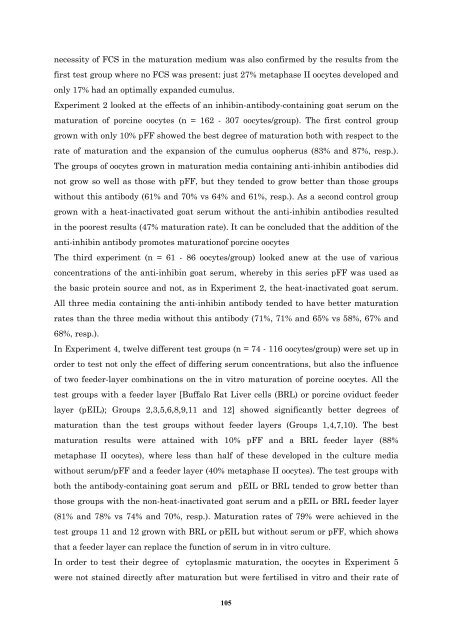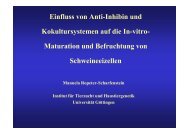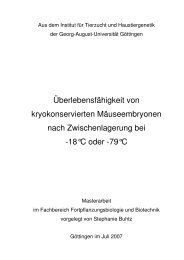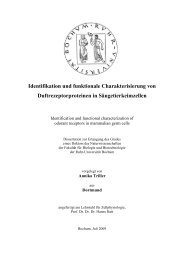In-vitro-Maturation porciner Oozyten auf Feederlayer ... - Dragon IVF
In-vitro-Maturation porciner Oozyten auf Feederlayer ... - Dragon IVF
In-vitro-Maturation porciner Oozyten auf Feederlayer ... - Dragon IVF
Sie wollen auch ein ePaper? Erhöhen Sie die Reichweite Ihrer Titel.
YUMPU macht aus Druck-PDFs automatisch weboptimierte ePaper, die Google liebt.
necessity of FCS in the maturation medium was also confirmed by the results from the<br />
first test group where no FCS was present: just 27% metaphase II oocytes developed and<br />
only 17% had an optimally expanded cumulus.<br />
Experiment 2 looked at the effects of an inhibin-antibody-containing goat serum on the<br />
maturation of porcine oocytes (n = 162 - 307 oocytes/group). The first control group<br />
grown with only 10% pFF showed the best degree of maturation both with respect to the<br />
rate of maturation and the expansion of the cumulus oopherus (83% and 87%, resp.).<br />
The groups of oocytes grown in maturation media containing anti-inhibin antibodies did<br />
not grow so well as those with pFF, but they tended to grow better than those groups<br />
without this antibody (61% and 70% vs 64% and 61%, resp.). As a second control group<br />
grown with a heat-inactivated goat serum without the anti-inhibin antibodies resulted<br />
in the poorest results (47% maturation rate). It can be concluded that the addition of the<br />
anti-inhibin antibody promotes maturationof porcine oocytes<br />
The third experiment (n = 61 - 86 oocytes/group) looked anew at the use of various<br />
concentrations of the anti-inhibin goat serum, whereby in this series pFF was used as<br />
the basic protein source and not, as in Experiment 2, the heat-inactivated goat serum.<br />
All three media containing the anti-inhibin antibody tended to have better maturation<br />
rates than the three media without this antibody (71%, 71% and 65% vs 58%, 67% and<br />
68%, resp.).<br />
<strong>In</strong> Experiment 4, twelve different test groups (n = 74 - 116 oocytes/group) were set up in<br />
order to test not only the effect of differing serum concentrations, but also the influence<br />
of two feeder-layer combinations on the in <strong>vitro</strong> maturation of porcine oocytes. All the<br />
test groups with a feeder layer [Buffalo Rat Liver cells (BRL) or porcine oviduct feeder<br />
layer (pEIL); Groups 2,3,5,6,8,9,11 and 12] showed significantly better degrees of<br />
maturation than the test groups without feeder layers (Groups 1,4,7,10). The best<br />
maturation results were attained with 10% pFF and a BRL feeder layer (88%<br />
metaphase II oocytes), where less than half of these developed in the culture media<br />
without serum/pFF and a feeder layer (40% metaphase II oocytes). The test groups with<br />
both the antibody-containing goat serum and pEIL or BRL tended to grow better than<br />
those groups with the non-heat-inactivated goat serum and a pEIL or BRL feeder layer<br />
(81% and 78% vs 74% and 70%, resp.). <strong>Maturation</strong> rates of 79% were achieved in the<br />
test groups 11 and 12 grown with BRL or pEIL but without serum or pFF, which shows<br />
that a feeder layer can replace the function of serum in in <strong>vitro</strong> culture.<br />
<strong>In</strong> order to test their degree of cytoplasmic maturation, the oocytes in Experiment 5<br />
were not stained directly after maturation but were fertilised in <strong>vitro</strong> and their rate of<br />
105





